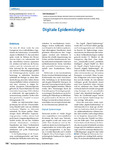2020-01-23Zeitschriftenartikel
Digitale Epidemiologie
Brockmann, Dirk
Digitale Epidemiologie ist ein relativ neues, rapide wachsendes Forschungsgebiet. Die technologische Revolution des letzten Jahrzehnts, die globale Vernetzung, der Informationsaustausch über soziale Medien und insbesondere die nahezu gesamtgesellschaftliche Nutzung mobiler Endgeräte ermöglichen es, individuenspezifische Daten mit einer Auflösung zu erfassen, die noch vor einigen Jahren unmöglich erschien. Diese Daten werden in der digitalen Epidemiologie untersucht, um epidemiologische Fragen besser beantworten zu können.
Dieser Artikel liefert einen Überblick. Es werden verschiedene Aspekte der digitalen Epidemiologie diskutiert. An Beispielen wird erläutert, wie epidemiologische und bioinformatische Daten auf interaktiven Internetplattformen zusammengeführt werden, wie durch Analyse der Inhalte und des Informationsaustauschs über soziale Medien und Netzwerke wichtige Erkenntnisse gewonnen werden und wie mithilfe mobiler Endgeräte in natürlichen Experimenten Kontakt- und Proximitätsnetzwerke rekonstruiert werden, um die Dynamik direkt übertragbarer Infektionskrankheiten besser verstehen, beschreiben und vorhersagen zu können.
Es wird erklärt, wieso die moderne Netzwerktheorie, aber auch Methoden des maschinellen Lernens und künstliche Intelligenz bei der Analyse sehr großer Datensätze wichtige Werkzeuge sind und wie traditionelle, statistische Ansätze der Infektionsepidemiologie durch diese neuen Methoden ergänzt werden.
Die ethischen Herausforderungen im Bereich Datenschutz, Datensicherheit und Persönlichkeitsrechte werden schließlich diskutiert. Konzepte und Wege, personenbezogene Verhaltensdaten einerseits nutzbar zu machen und andererseits die Datenhoheit jedes Einzelnen zu wahren, werden skizziert. Digital epidemiology is a new and rapidly growing field. The technological revolution we have been witnessing during the last decade, the global rise of the Internet, the emergence of social media and social networks that connect individuals worldwide for information exchange and social interactions, and the almost complete social penetration of mobile devices such as smartphones provide access to data on individual behavior with unprecedented resolution and precision. In digital epidemiology, this type of high-resolution behavioral data is analyzed to advance our understanding of, for example, infectious disease dynamics and improve our abilities to forecast epidemic outbreaks and related phenomena.
This article provides an overview on the topic. Different aspects of digital epidemiology are alluded to. Based on examples, I will explain how epidemiological data is integrated on new comprehensive and interactive websites, how the analysis of interactions and activities on social media platforms can yield answers to epidemiological questions, and finally how individual-based data collected by smartphones or wearable sensors in natural experiments can be used to reconstruct contact and physical proximity networks the knowledge of which substantially improves the predictive power of computational models for transmissible infectious diseases.
The challenges posed in terms of privacy protection and data security will be discussed. Concepts and solutions will be explained that may help to improve public health by leveraging the new data while at the same time protecting the individual’s data sovereignty and personal dignity.
Dateien zu dieser Publikation

